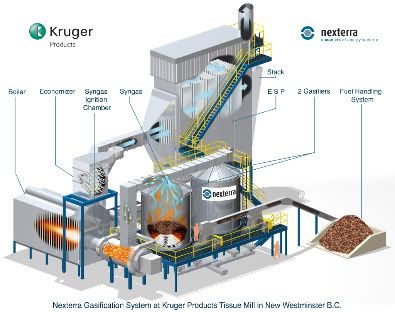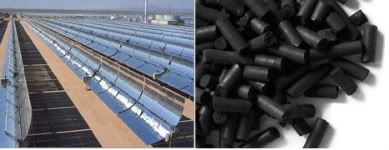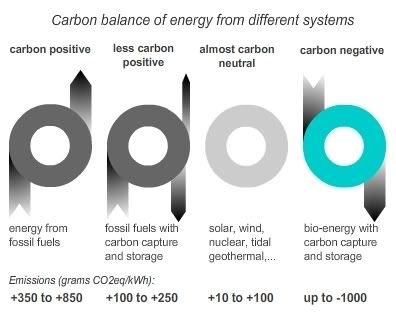National Geographic documentary on terra preta and biochar: solve multiple environmental crises simultaneously
Biochar, or the sequestration of char in nutrient-poor soils to make them more fertile, is gaining interest from a growing number of conservationists, ecologists, climate activists and anthropologists because it is increasingly seen as one of the few realistic ways to tackle multiple environmental and social crises simultaneously: hunger, soil depletion, deforestation and the loss of biodiversity and ecosystem services that go with it, fresh water depletion, land ownership, energy poverty and even climate change. National Geographic is the latest to focus on this almost too-good-to-be-true land use strategy, which is based on the old, very fertile "terra preta" soils that have been discovered in the Amazon.
NG's article 'Superdirt Made Lost Amazon Cities Possible?' is an introduction to a new documentary that analyses how pre-columbian Amazonian societies were built on the ingeniously engineered black soils. The film "Lost Cities of the Amazon" [video fragments here and here] builds on the recent insights that these forests may have been home to vast urban networks that sustained large populations for thousands of years. Scientists now think that the 'black gold' agriculture - the biochar these communities put in their soils - not only was the key to this sustainable way of life, but that it may help save the planet today.
But over the past several decades, researchers have discovered tracts of productive terra preta—"dark earth." The human-made soil's chocolaty color contrasts sharply with the region's natural yellowish soils.
Research in the late 1980s was the first to show that charcoal made from slow burns of trees and woody waste is the key ingredient of terra preta.
With the increased level of agriculture made possible by terra preta, ancient Amazonians would have been able to live in one place for long periods of time, says geographer and anthropologist William Woods of the University of Kansas, who studies ancient Amazonian settlements.
Today scientists are racing to tease apart the terra-preta recipe. The special soil has been touted as a way to restore more sustainable farming to the Amazon, feed the world's hungry, and combat global warming.
The terra-preta charcoal, called biochar, attracts certain fungi and microorganisms. Those tiny life-forms allow the charcoal to absorb and retain nutrients that keep the soil fertile for hundreds of years, said Woods, whose team is among a few trying to identify the crucial microorganisms:
 energy :: sustainability :: biomass :: bioenergy :: terra preta :: biochar :: soil depletion :: poverty :: deforestation :: biodiversity :: climate change ::
energy :: sustainability :: biomass :: bioenergy :: terra preta :: biochar :: soil depletion :: poverty :: deforestation :: biodiversity :: climate change ::
"The materials that go into the terra preta are just part of the story. The living member of it is much more," he said. For one thing, the microorganisms break up the charcoal into smaller pieces, creating more surface area for nutrients to cling to, Woods said.
Anti-Global-Warming Weapon?
Soil scientist Johannes Lehmann of Cornell University is also racing to recreate terra preta.
The Amazonian dark soils, he said, are hundreds to thousands of years old, yet to this day they retain their nutrients and carbons, which are held mainly by the charcoal.
This suggests that adding biochar could help other regions of the world with acidic soils to increase agricultural yields.
Plus, Lehmann said, biochar could help reduce the amount of greenhouse gas emissions released into the atmosphere from the burning of wild lands to create new farm fields. (Learn how greenhouse gas emissions may worsen global warming.)
For example, specialized power plants could char agricultural wastes to generate electricity.
The process would "lock" much carbon that would have otherwise escaped into the atmosphere in the biochar. The biochar could then be put underground, in a new form of terra preta, thereby sequestering the carbon for centuries, Lehmann suggests.
Current Amazonian farming relies heavily on slash-and-burn agriculture—razing forests, then burning all of what's left.
By reverting to the ancient slash-and-char method—burning slowly and then mixing the charcoal into the soil—Amazonian carbon dioxide emissions could be cut nearly in half, according to Woods, of the University of Kansas.
With slash-and-burn, he noted, 95 percent of the carbon stored in a tree is emitted to the atmosphere. Slash-and-char emits about 50 percent, he said.
"The rest is put into different forms of black carbon, most of which are chemically inert for long periods of time—thousands of years."
In addition, the technique would allow many farmers to stay sedentary, Woods said.
Because the soil would apparently remain fertile for centuries, "they don't have to cut down the forest constantly and send it up into the atmosphere," he said.
References:
National Geographic: Superdirt Made Lost Amazon Cities Possible? - November 19, 2008.
National Geographic: Ancient Amazon Cities Found; Were Vast Urban Network - August 28, 2008.
University of California at Los Angeles: Susanna Hecht
University of Florida: Michael Heckenberger
University of Kansas: William Woods
Cornell University: Johannes Lehmann
Article continues
NG's article 'Superdirt Made Lost Amazon Cities Possible?' is an introduction to a new documentary that analyses how pre-columbian Amazonian societies were built on the ingeniously engineered black soils. The film "Lost Cities of the Amazon" [video fragments here and here] builds on the recent insights that these forests may have been home to vast urban networks that sustained large populations for thousands of years. Scientists now think that the 'black gold' agriculture - the biochar these communities put in their soils - not only was the key to this sustainable way of life, but that it may help save the planet today.
Now scientists are trying to recreate the recipe for the apparently human-made supersoil, which still covers up to 10 percent of the Amazon Basin. Key ingredients included of dirt, charcoal, pottery, human excrement and other waste.Scientists have long thought the river basin's tropical soils were too acidic to grow anything but the hardiest varieties of manioc, a starch-rich root crop.
If recreated, the engineered soil could feed the hungry and may even help fight global warming, experts suggest.
But over the past several decades, researchers have discovered tracts of productive terra preta—"dark earth." The human-made soil's chocolaty color contrasts sharply with the region's natural yellowish soils.
Research in the late 1980s was the first to show that charcoal made from slow burns of trees and woody waste is the key ingredient of terra preta.
With the increased level of agriculture made possible by terra preta, ancient Amazonians would have been able to live in one place for long periods of time, says geographer and anthropologist William Woods of the University of Kansas, who studies ancient Amazonian settlements.
As a result you get social stratification, hierarchy, intertwined settlement systems, very large scale. And then 1492 happens. The arrival of Europeans brought disease and warfare that obliterated the ancient Amazonian civilizations and sent the few survivors deep into the rain forest to live as hunter-gatherers. It completely changed their way of living. - Professor WoodsMagic Soil?
Today scientists are racing to tease apart the terra-preta recipe. The special soil has been touted as a way to restore more sustainable farming to the Amazon, feed the world's hungry, and combat global warming.
The terra-preta charcoal, called biochar, attracts certain fungi and microorganisms. Those tiny life-forms allow the charcoal to absorb and retain nutrients that keep the soil fertile for hundreds of years, said Woods, whose team is among a few trying to identify the crucial microorganisms:
 energy :: sustainability :: biomass :: bioenergy :: terra preta :: biochar :: soil depletion :: poverty :: deforestation :: biodiversity :: climate change ::
energy :: sustainability :: biomass :: bioenergy :: terra preta :: biochar :: soil depletion :: poverty :: deforestation :: biodiversity :: climate change :: "The materials that go into the terra preta are just part of the story. The living member of it is much more," he said. For one thing, the microorganisms break up the charcoal into smaller pieces, creating more surface area for nutrients to cling to, Woods said.
Anti-Global-Warming Weapon?
Soil scientist Johannes Lehmann of Cornell University is also racing to recreate terra preta.
The Amazonian dark soils, he said, are hundreds to thousands of years old, yet to this day they retain their nutrients and carbons, which are held mainly by the charcoal.
This suggests that adding biochar could help other regions of the world with acidic soils to increase agricultural yields.
Plus, Lehmann said, biochar could help reduce the amount of greenhouse gas emissions released into the atmosphere from the burning of wild lands to create new farm fields. (Learn how greenhouse gas emissions may worsen global warming.)
For example, specialized power plants could char agricultural wastes to generate electricity.
The process would "lock" much carbon that would have otherwise escaped into the atmosphere in the biochar. The biochar could then be put underground, in a new form of terra preta, thereby sequestering the carbon for centuries, Lehmann suggests.
Current Amazonian farming relies heavily on slash-and-burn agriculture—razing forests, then burning all of what's left.
By reverting to the ancient slash-and-char method—burning slowly and then mixing the charcoal into the soil—Amazonian carbon dioxide emissions could be cut nearly in half, according to Woods, of the University of Kansas.
With slash-and-burn, he noted, 95 percent of the carbon stored in a tree is emitted to the atmosphere. Slash-and-char emits about 50 percent, he said.
"The rest is put into different forms of black carbon, most of which are chemically inert for long periods of time—thousands of years."
In addition, the technique would allow many farmers to stay sedentary, Woods said.
Because the soil would apparently remain fertile for centuries, "they don't have to cut down the forest constantly and send it up into the atmosphere," he said.
References:
National Geographic: Superdirt Made Lost Amazon Cities Possible? - November 19, 2008.
National Geographic: Ancient Amazon Cities Found; Were Vast Urban Network - August 28, 2008.
University of California at Los Angeles: Susanna Hecht
University of Florida: Michael Heckenberger
University of Kansas: William Woods
Cornell University: Johannes Lehmann
Article continues
 --------------
--------------
 Taiwan's Feng Chia University has succeeded in boosting the production of hydrogen from biomass to 15 liters per hour, one of the world's highest biohydrogen production rates, a researcher at the university said Friday. The research team managed to produce hydrogen and carbon dioxide (which can be captured and stored) from the fermentation of different strains of anaerobes in a sugar cane-based liquefied mixture. The highest yield was obtained by the Clostridium bacterium.
Taiwan's Feng Chia University has succeeded in boosting the production of hydrogen from biomass to 15 liters per hour, one of the world's highest biohydrogen production rates, a researcher at the university said Friday. The research team managed to produce hydrogen and carbon dioxide (which can be captured and stored) from the fermentation of different strains of anaerobes in a sugar cane-based liquefied mixture. The highest yield was obtained by the Clostridium bacterium.





 Increasing levels of nitrogen deposition associated with industry and agriculture can drive soils toward a toxic level of acidification, reducing soil fertility, plant growth and polluting surface waters, according to a new study
Increasing levels of nitrogen deposition associated with industry and agriculture can drive soils toward a toxic level of acidification, reducing soil fertility, plant growth and polluting surface waters, according to a new study 









Saturday, November 22, 2008
FAO reports major success: healthy cassava makes comeback in volatile Great Lakes region
By the last planting season, virus-free cassava planting material had been distributed to some 330,000 smallholders in countries struck by the virus: Burundi, the Democratic Republic of Congo, Rwanda and Uganda. The improved crop now benefits a total of some 1.65 million people, and its uptake will speed up further.
Having cassava back on the table is of major importance, especially to the region's most vulnerable, who have been hit hard by the recent upsurge in food prices, said Eric Kueneman Chief of FAO's Crop and Grassland Service. He added that boosting the production of local crops like cassava is a pillar of FAO's response to the current crisis, which was caused by commodity speculation.
In the Great Lakes region though, high prices of food and fertilizer are just part of the problem. As the recent violence in eastern DR Congo tragically demonstrates, the region is still grappling with peace. But, especially under circumstances of extreme instability, cassava can make a crucial difference.
Cassava roots can be harvested whenever there is a need, or left in the ground when farmers are driven from their land. Also, cassava is not an easy prey, when land is unattended: thieves will find it very difficult to dig it from the ground.
Disease causes food shortage
Each person in Africa eats around 80 kg of cassava per year. So, when an aggressive strain of a virus called Cassava Mosaic Disease (CMD) decimated harvests throughout the Great Lakes region, consequences were disastrous.
In Uganda, for instance, where CMD has destroyed 150,000 hectares of cassava since the early nineties - a loss estimated at $US 60 million per annum - food shortages resulting from CMD led to localized famines in 1993 and 1997. CMD appeared in Burundi in 2002. Yield losses attaining ninety percent were record. Prices sky-rocketed. And it came right on top of a devastating civil war. According to FAO’s 2006 State of Food Insecurity in the World (SOFI) report, undernourishment affected two-thirds of the population in 2001/3, compared to less than half before hostilities begun ten years earlier.
Tackling the epidemic began with a series of disease-free varieties developed by one of FAO's research partners, the International Institute of Tropical Agriculture in Nigeria, which were multiplied in nurseries of a multitude of partners, including national research institutions, local governments and civil society, eventually producing enough planting stakes for mass distribution to the population.
Salvator Kaboneka, an FAO agronomist, explains how it all began on “the mother plantation,” as he calls it, a cassava field in Mparambo, not far from Munyika. Here, on 20 hectares, FAO started planting disease free stems in 2005, initially with Belgian and American support.
At the same time, FAO embarked on a campaign to boost the capacity and efforts of individual countries in the region, launching a regional cassava initiative in 2006 with funding of several donors led by ECHO - the European Union's humanitarian aid agency - , which has contributed € 3.3 million to FAO's different cassava operations since:
Diner's ready
Burundi's northern Cibitoke province lies in the epicentre of the CMD epidemic. Its fields, barren until a year ago, now bustle with green from cassava leaves. "It's sweet, not bitter," says Ernest Nduwimana, a young farmer who lost his father during Burundi's civil war, holding up a huge cassava root he has just unearthed.
The crop was good this year, Ernest says. There is enough to feed his family until the next harvest, which he is already preparing to plant with quality cuttings from his own cassava plants. Then, after a long day, he returns home, where his mother has prepared bugari, a local dish based on cassava flour and served with beans and fish.
EU support
The European Union is one of FAO's most steadfast and generous partners in promoting sustainable rural development to improve the lives of the poor, contributing over US$ 100 million to FAO's field programme in 2007.
Working together on the ground in developing countries worldwide, improving food security in emergencies, employing research to foster food safety and quality, stimulating information-gathering to build policy, sharing know-how and involving partners in policy-making, the EU and FAO fight poverty at its root.
Cassava's potential: food and fuel
At a global conference held recently in Gent, Belgium, the FAO together with cassava scientists and food security analysts called for a significant increase in investment in research and development to boost farmers’ yields of cassava and explore promising industrial uses for the crop, including production of biofuels.
The tropical root crop could help protect both the food and energy security of poor countries now threatened by soaring food and oil prices, the congress concluded. The FAO reiterated what many tropical agronomists and development experts have said about cassava in the past (e.g. CIAT thinks cassava ethanol could benefit millions of the world's poorest farmers).
The scientists, who have formed an international network called the Global Cassava Partnership (GCP21), said the world community could not continue to ignore the plight of low-income tropical countries that have been hardest hit by rising oil prices and galloping food price inflation.
According to them, cassava has a very large potential as a food and industrial crop: at present, average yields are barely 20% of what they should be under optimum conditions and with basic inputs. The crop grows well on poor, degraded soils and in a vast agro-ecological zone.
Cassava field residues and processing waste - such as peels, mill effluent, and the crop's woody stems - could be converted into biogas, biohydrogen or solid biomass for electricity production.
International Institute of Tropical Agriculture
(IITA) is an international non-profit R4D organization since 1967 supported primarily by the CGIAR.
The regional campaign to combat CMD was developed with technical support of FAO’s Crop and Grassland Service. The service helps FAO member countries achieve sustainable increases in production of crops and grasslands, through plant improvement, application of plant biotechnology, development of integrated production systems, and rational grassland management.
The Global Cassava Partnership for Genetic Improvement (GCP21) is an international alliance of research institutions dedicated to increase research and funding on cassava, and dedicated to develop several biotechnological tools to permit breakthroughs in the coming years, to double the cassava productivity in a 15 year time frame.
ECHO is the European Commission Humanitarian Aid agency, and one of the FAO's most loyal partners.
References:
FAO: Cassava’s comeback - November 13, 2008.
FAO: Cassava for food and energy security - July 25, 2008.
FAO: Ernest’s dream: Farmers in Burundi are planting cassava again, with EU/FAO support - 2007
Biopact: FAO calls for boost to cassava R&D for biofuels and food - 'enormous' potential - July 26, 2008
Article continues
posted by Biopact team at 4:24 PM 1 comments links to this post
